Text
Bikini Atoll: Nuclear tests, Swimsuits and SpongeBob
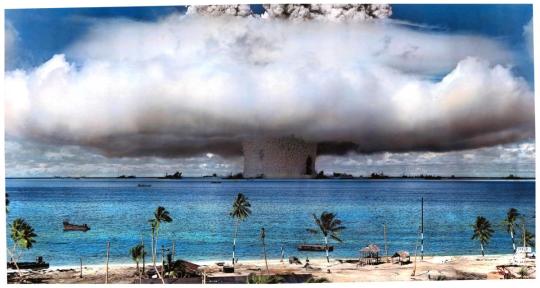
In 1945, shortly after World War II, the Cold War began which saw the U.S and the Soviet Union engage in a race to build nuclear weapons. The U.S chose to test nuclear weapons on Bikini Atoll.
Bikini Atoll (roughly meaning "coconut place") is a coral reef in the Marshall Islands. It was chosen due to its remote location away from air and sea traffic. Navy Commodore Ben H. Wyatt, who was the military governor of the Marshall Islands, made an appeal to the Bikinians. He told them that their land was needed for "the good of mankind and to end all world wars." They were not fully informed of the nuclear tests and believed that they would soon be able to return to their homes, and so they agreed to move.
The U.S. government constantly relocated the Bikini islanders from one island to another providing them with minimum support. They were plagued with malnutrition (due to inadequate food and water supply) and starvation.
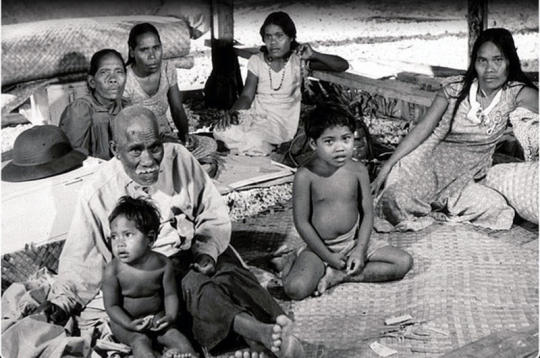
Meanwhile, over 42,000 US military personnel, 242 naval ships, 156 planes and 5,400 experimental rats, goats, and pigs had landed on Bikini Atoll to begin nuclear testing. The U.S detonated 23 nuclear devices between 1946 and 1958 at seven test sites. The test weapons were detonated on the reef itself, on the sea, in the air and underwater. On March 1, 1954, a detonation on Bikini Atoll known as “Bravo” created an explosion equivalent to 1,000 Hiroshima-sized bombs.
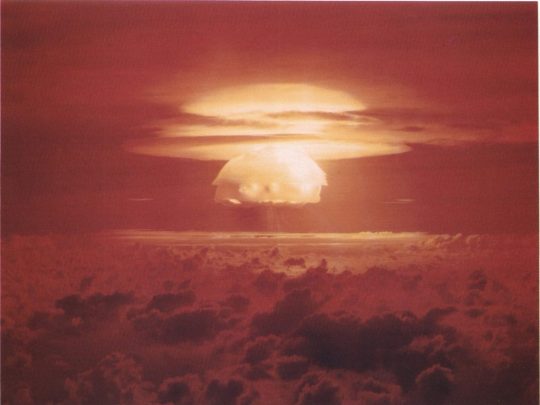
In the 1970s, the Atomic Energy Commission declared Bikini Atoll “virtually free of radiation”, and the Bikinians were told to return to their island. They were reassured that the well water and locally-grown food were safe to consume. However, eight years later scientists confirmed that the island actually still contained dangerous levels of radiation and the Bikinians were forced to leave permanently. The radiation levels today still far exceed levels considered to be habitable, and are even higher than those at Chernobyl and Fukushima.
The link to 'SpongeBob'
There are many cartoon theories about SpongeBob SquarePants, Bikini Bottom being a nuclear test site actually holds some truth. It has been confirmed that Bikini Bottom is located beneath Bikini Atoll. One fan theory has it that SpongeBob and his collection of weird and wonderful friends are the result of mutations caused by radiation on Bikini Atoll above them.
The link to the 'Bikini'
Two French designers rivalled to create the world’s smallest suit: Jacques Heim debuted the “Atome,” named after the atom; while Louis Réard came up with an even tinier creation called the “Bikini.” Réard thought his invention was as ‘small and devastating’ as the atom bomb, and named it after this infamous location on the other side of the planet, hoping to capitalize on the attention the tests received.
#history#politics#spongebon squarepants#spongebob#swim shorts#fukushima#chernobyl#bikini atoll#island#colonization#colonialism#usa today#nuclear#culture#news#books and libraries
4 notes
·
View notes
Text
What is the Black Panther movement?
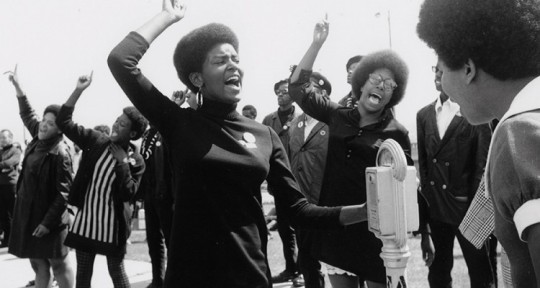
What is the movement described by the FBI as the “greatest threat to the internal security of the country”?
To understand the purpose of the movement, we have to understand the history of slavery in America. Slavery in the USA was abolished in 1865, but black Americans did not have equality. The Civil Rights Movement, led by Martin Luther King Jr, gave black Americans legal equality. However, black Americans continued to suffer economic and social inequality. Black communities were subject to poor living conditions, joblessness, chronic health problems, violence, and limited means to change their circumstances. These communities were also subject to increased use of police violence.
The Black Panther Party was founded by Huey P. Newton and Bobby Seale. The party’s original purpose was to patrol black neighbourhoods to protect against police brutality.
The Black Panthers used their second amendment right to bear arms (guns) in public and championed the use of arms in self-defense against police brutality. Violent confrontations between the various law enforcement agencies and the black panther party became common at the height of their influence and led to the founding of the COINTELPRO program which used extra-legal methods to assassinate, discredit and imprison high ranking black panther party members.
Years later, the FBI publicly apologised for “wrongful uses of power”.
90 notes
·
View notes
Text
Where did the terms 'Right Wing' and 'Left Wing' originate and what do they mean?
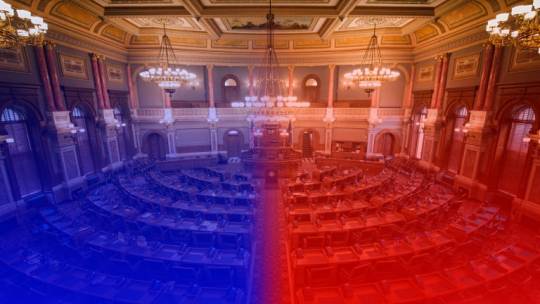
Where did the terms originate?
In 1789, the French National Assembly began drafting a constitution. The delegates (members of the Assembly) were divided over how much authority King Louis XVI should have. The anti-royalist revolutionaries (against the power held by the monarchy) seated themselves at the left of the assembly hall and the more conservative, aristocratic supporters of the monarchy (in support of the power held by the monarchy) gathered to the right.
What do the terms mean?
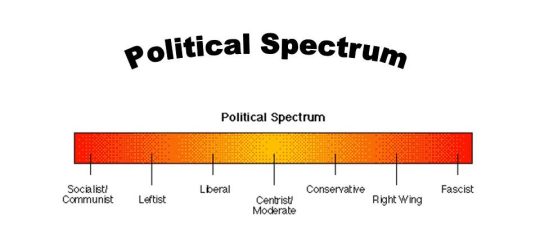
What the left and right means is variable from country to country. Generally, a country will have left wing, centrist (middle) and right wing parties.
Economics: the left generally advocate for higher taxation (the richer you are, the more tax you pay) which allows more money to be spent on services such as hospitals, roads etc. The left look to nationalise services - nationalisation refers to the process of transforming privately-owned assets (private business owning a service or business) to public ownership. This ensures everyone has access, services are maintained efficiently and prices remain low.
The right focuses on lower taxation and lower spending on services such as hospitals. The rich will pay for the services they require e.g. the rich will use private hospitals rather than NHS doctors. The right generally look to privatise services to monopolise (a market structure in which a company or a few companies take control of the supply and price of a particular product or service) and make profit.
Social issues: the left focuses on more progressive policies on issues such as marriage, gender etc. The right focuses on protecting 'traditional' values.
Left and Right parties in the UK
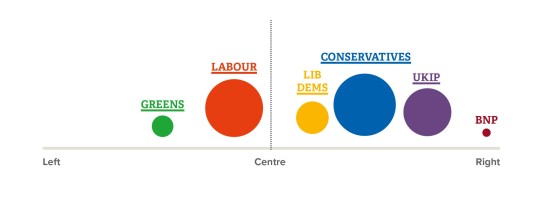
In the UK, the Green Party and Labour are viewed as 'Left wing' parties, Liberal Democrats as a 'Centre or Centrist' party and the Conservatives, UKIP (UK Independence Party), and BNP (British National Party) as 'Right wing' parties.
A parties political leaning also depends on the leader of the party, for example Labour under Jeremy Corbyn were viewed as a very left wing party whereas Labour under the current leader, Keir Stramer, are viewed as a more centrist party (some may even argue Labour are now leaning more to the right).
Who votes Left and who votes Right?
The 2019 elections offers insight into how people vote depending on factors such age, gender and education level.

The majority of people who vote for Labour (left wing) are younger voters whereas older voters vote for Conservatives (right wing).

The initial figures show there is very little difference between women and men with 31% of men voting Labour and 35% of women.
However, when you break this down you notice voting intentions are very different among the very youngest. 46% of young men voted Labour compared to 65% of young women - a gap of 19%.
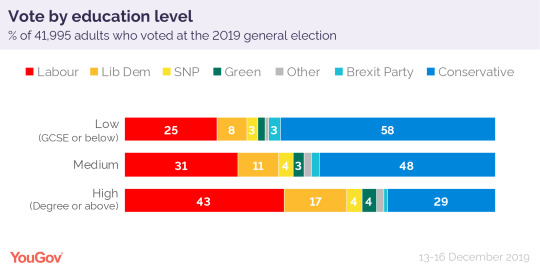
People with lower education levels voted for the Conservatives; 58% of people with education levels of GCSE's or below voted for the Conservatives compared to 25% for Labour. Labour were more popular with people with people with education levels of Degree or above.
Find out your political leaning: https://tpointuk.co.uk/quiz/political-compass/
2 notes
·
View notes
Text
Can the NHS really be privatised?
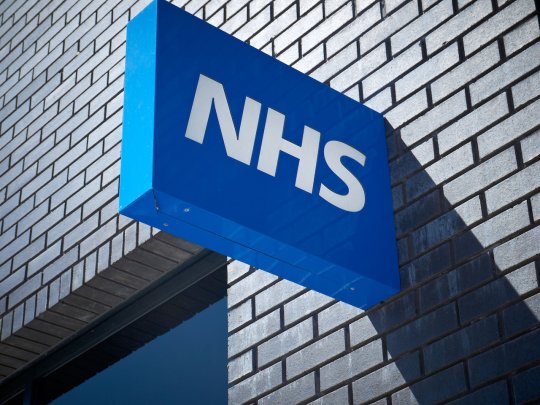
What is privatisation?
In this context, privatisation means the transfer of assets from the public (government-owned) sector to the private (private busines owner) sector. Conservative governments have been experimenting with privatisation for a while. By the 80s and 90s , majority of government-owned (public) industries were sold such as British gas and British Telecom (BT). Parts of the royal mail were privatised soon after.
What are the advantages and disadvantages?
Advantages of privatisation include:
Increased competition so customers have more choice.
People who are able to pay will receive better service.
Disadvantages include:
If a service like the NHS is privatised, the provider has an incentive to oversupply, for example, ordering tests that the patient does not really need. This means the patient will have to pay more.
Poor and working class people and communities would be affected. People who cannot afford it may risk their health by not visiting a doctor.
Who takes responsibility if something goes wrong? When the railway (train) service was privatised different companies operated in different areas, e.g. the company 'Arriva' runs the London underground whereas the company 'Abellio' runs the trains in Stansted. This led to areas where it was unclear who had responsibility. For example, in the Hatfield rail crash different companies fought over who was responsible.
It can create a monopoly. A monopoly is when one company dominates the industry. An example is the supply of water to homes and businesses. Each region in the UK has one single supplier of water so people who live in Yorkshire buy their water from Yorkshire water.
What happens now?
In November 2019, a 451 page document was leaked online which confirmed that the conservative prime minister, Boris Johnson, was in talks to sell the NHS in a trade deal with the US. The document showed that in some sectors, such as pharmaceuticals, they had reached advanced negations. Currently, the EU has strict standards, so the US want the UK to adopt US standards and regulations so that it is easier for US companies to sell products in the UK. So, it will become more clear what the future holds for the NHS following the UK's exit from the EU.
1 note
·
View note
Text
General elections - A simple guide

The basics
In a general election, the general public will vote to choose an MP for their constituency. Generally, general elections are held every 5 years. But sometimes they are held earlier than that. For this to happen, at least two-thirds of MPs have to agree to it in a vote.
There are 650 constituencies in the UK. The candidate with the most votes in the constituency is elected as an MP. That MP now has seat in Parliament. To win a majority, a political party needs to get 326 MPs, so they need 326 seats in parliament. It is called a majority because the party has won more seats than all of the other parties added together. The leader of the party will become the prime minister.
What happens if a party doesn't win 326 MPs?
If no party has a majority, it is called a hung parliament. When this happens, there are two options:
Coalition government: parties can decide to join with another party so that together they can have 326 or more seats. They then rule the country together. This happened in 2010 when the Conservatives joined up with the Liberal Democrats to create a government together.
Minority government: when a party wins the most MP’s (seats) out of all the other parties, but doesn’t have a majority, and they don’t want to join with another party, they can rule as a minority party. This happened in 2017; the conservatives won the most MP’s but didn’t have a majority because they only had 306 seats.
What do MP’s do?
MPs split their time between working in Parliament and working in their constituency. When they are working in Parliament, they can suggest and consider new laws, and take part in important votes on how the country is run. They can also bring up issues that matter to people in their constituency with important members of the government.
What is parliament?
Parliament is where decisions and laws are made. There are two parts to Parliament: the House of Commons (elected) and the House of Lords (unelected). The House of Commons is made up of MP’s. Members of the House of Lords are unelected. Sometimes people inherit their status as a Lord from their family. Others are specially chosen by the prime minister because they are experts in their field, like Lord Sugar. The House of Lords debate new laws proposed by MPs (House of Commons), and makes suggestions. When both Houses agree on the law, the Queen then approves it.
2 notes
·
View notes